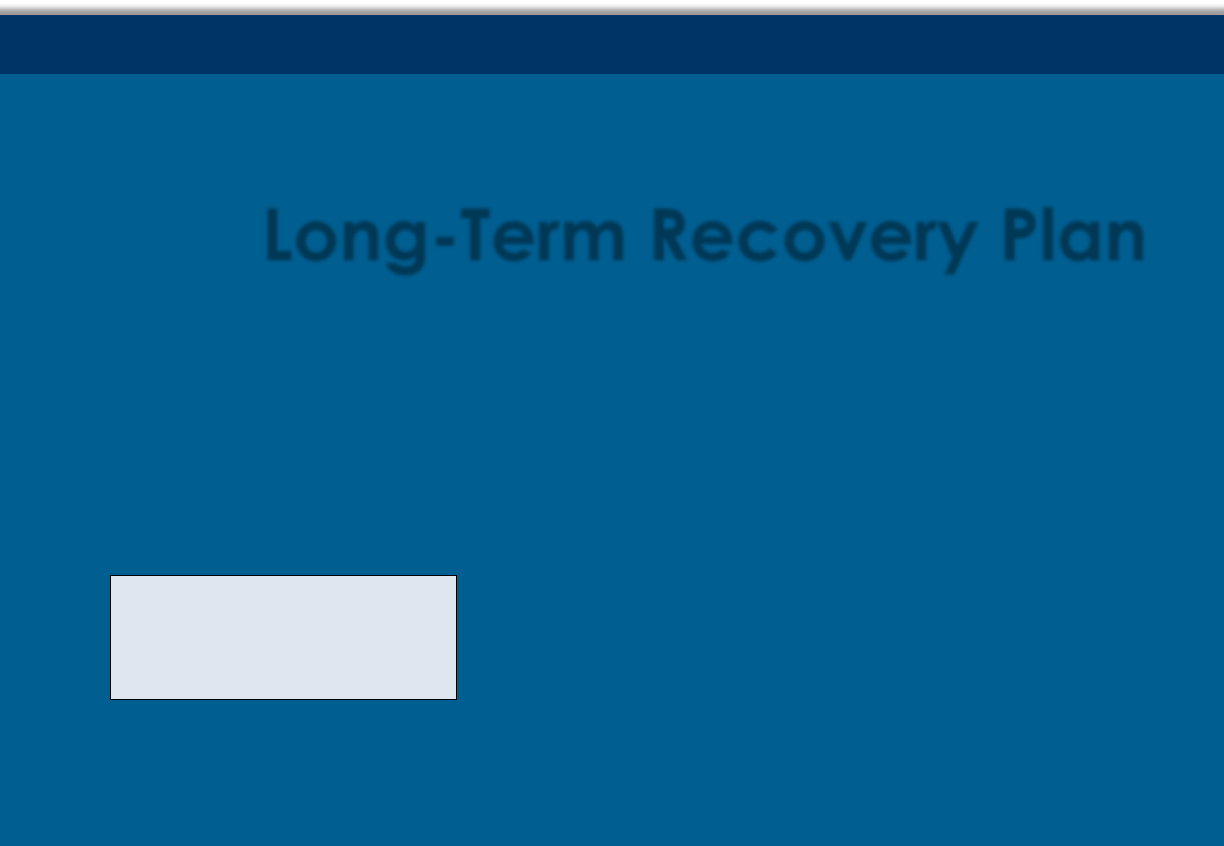
[Insert image here]
[Insert Disaster Name]
Long-Term Recovery Plan
[Insert County/Jurisdiction Name]
[INSERT DATE OF PUBLICATION]
[Insert jurisdiction’s logo here.]

[Disaster Name] Long-Term Recovery Plan
[Jurisdiction/County Name]
(This page intentionally left blank.)

[Disaster Name] Long-Term Recovery Plan
[Jurisdiction/County Name]
TABLE OF CONTENTS
HOW TO USE THIS DOCUMENT 1
ACKNOWLEDGEMENTS 3
EXECUTIVE SUMMARY 4
RECORD OF CHANGES 5
INTRODUCTION 6
Purpose 6
Scope 6
Situation Overview 7
COMMUNITY ENGAGEMENT 8
IMPACTS & RECOVERY NEEDS 9
Community Planning & Capacity Building (CPCB) 10
Economic 11
Health & Social Services (HSS) 12
Housing 13
Infrastructure Systems 14
Natural & Cultural Resources (NCR) 14
RECOVERY PROJECTS 16
What is a Recovery Project? 16
Recovery Project Domains 16
[Insert name of RSF here] Recovery Projects 17
IMPLEMENTATION & MAINTENANCE 18
Roles & Responsibilities 18
Maintenance Schedule 18
APPENDICES 20
Appendix A: Contact Lists 20
Appendix B: Data Tables 20
Appendix C: Reference Documents 20
Appendix D: Community Engagement Results 20
Appendix E: Acronyms 20

[Year & Disaster Name] Long-Term Recovery Plan
[Jurisdiction/County Name] 1
HOW TO USE THIS DOCUMENT
This document is a template designed to assist local jurisdictions in developing a
Long-Term Recovery Plan based on the results of a local recovery needs
assessment. As such, this template represents the beginning of a planning
process in the development and implementation of a community’s recovery
strategy. The template is intended to assist local recovery planners by providing
an outline of information that is generally applicable to most local governments.
The accompanying Long-Term Recovery Plan Guide provides detailed
examples and resources that will assist jurisdictions with populating and
expanding the template into a full plan.
To ensure success during implementation, the development of this plan should
follow a strategic planning process to align the needs of the Whole Community
and ensure the plan is integrated into the community’s Emergency Operations
Plan, General Plan (and associated elements), Local Hazard Mitigation Plan,
Climate Action Plan, and the Comprehensive Economic Development Strategy,
among others. Jurisdictions are encouraged to include images of the disaster,
data visualizations, and graphics to support key points and objectives.
The following steps should be followed to guide the development of this
template into a plan:
1. Forming a Collaborative Planning Team composed of representatives
from the local government, non-profit organizations, private sector, and
community members. The team should work together collaboratively to
gather information on disaster impacts, assess unmet needs, identify
partners, and develop projects for the plan.
2. Preparation, Review, and Approval are necessary for ensuring the plan is
thorough and effective. This stage includes gathering data, identifying
priorities, and developing specific recovery strategies. The plan should be
reviewed by relevant stakeholders and approved by the designated
authority before implementation.
3. Implementation and Maintenance are key components of the recovery
process. The plan should be implemented as soon as possible after a
disaster and regularly reviewed and updated to ensure it remains relevant
and effective. This includes monitoring progress, identifying and
addressing any issues, and updating the plan as needed. Overall, a Long-
Term Recovery Plan is a critical tool for guiding the recovery of a
community after a major disaster.

[Year & Disaster Name] Long-Term Recovery Plan
[Jurisdiction/County Name] 2
For additional guidance on the implementation of the recovery planning
process, please refer to FEMA Comprehensive Planning Guidance 101,FEMA Pre-
Disaster Recovery Planning Guide for Local Governments, and FEMA Pre-Disaster
Recovery Planning Guide for Tribal Governments.
For additional resources, including the California Disaster Recovery Framework,
refer to the Cal OES Recovery Support Functions web page.
The Long-Term Recovery Plan template and associated guidance are initial
drafts. The Cal OES Interagency Recovery Coordination Group welcomes
feedback to improve the document. Feedback, questions, and requests for
technical assistance may be submitted to [email protected].
Note: Information in black font within the document represents information that
may require little, if any, modification. Words or phrases bracketed in [red font]
indicate where information tailored to the specific local government should be
developed and inserted. Template instructions frequently appear in call-out
boxes to keep them separate from plan text and to limit the amount of red text
that appears throughout this document; call-out boxes may be deleted during
the drafting process when they are no longer needed. All red text should be
changed to black or deleted before completion of the plan. Disaster graphics,
images, or data visualizations may be included to further demonstrate
ownership of the plan.
[This section should be deleted after the Long-Term Recovery Plan is finalized.]

[Year & Disaster Name] Long-Term Recovery Plan
[Jurisdiction/County Name] 3
ACKNOWLEDGEMENTS
[Use this section to list stakeholders, include a forward from a key stakeholder, or
outline the recovery team structure.]

[Year & Disaster Name] Long-Term Recovery Plan
[Jurisdiction/County Name] 4
EXECUTIVE SUMMARY
[After developing the Long-Term Recovery Plan, local jurisdictions may choose
to develop an Executive Summary that captures important information
presented in the plan. Traditionally, the Executive Summary is no longer than 2-3
pages.
The purpose of the Executive Summary is to provide a concise overview of the
recovery plan, enabling the reader to grasp central concepts in a succinct
manner. While the inclusion of an Executive Summary is discretionary, it is
particularly beneficial when the primary document is extensive.]

[Year & Disaster Name] Long-Term Recovery Plan
[Jurisdiction/County Name] 5
RECORD OF CHANGES
Version No.
Changes Made
Date
Updated By

[Year & Disaster Name] Long-Term Recovery Plan
[Jurisdiction/County Name] 6
INTRODUCTION
Purpose
The purpose of the [Disaster Name] Long-Term Recovery Plan is to guide the
rebuilding and revitalization of [Insert County/Jurisdiction Name] following the
[Insert Year] [Insert Disaster Name] to facilitate a coordinated and efficient
process for operationalizing recovery objectives and strategies. This plan outlines
the process for addressing the unmet needs of disaster survivors, businesses, and
the local government and restoring the community's physical, economic, and
social infrastructure.
The plan includes strategies for addressing the needs of survivors, businesses,
and local governments while increasing resilience to reduce the community's
risk during future disasters; and also serves as a resource for obtaining external
support through the development of grant applications for funding, technical
assistance, and other types of resources.
The [Disaster Name] Long-Term Recovery Plan has been developed by the
[Insert Name of Committee] which includes representatives from [Insert Names
of Government Agencies, Nonprofit Organizations, Faith-Based Organizations,
private sector as appropriate.]
Scope
The [Insert Disaster Name] Long-Term Recovery Plan provides an overview of
[Insert County/Jurisdiction Name] community assets, disaster impacts, and
needs to realize recovery of the Whole Community. The plan will evolve over
time as funding is allocated and projects are implemented to provide
stakeholders with updates on recovery progress and new risks, needs, and
projects.

[Year & Disaster Name] Long-Term Recovery Plan
[Jurisdiction/County Name] 7
Situation Overview
Insert description of disaster event including:
• Dates of incident
• Quantitative disaster data (acres burned, Richter scale mark, flood
levels)
• Dates of requests for assistance and declarations and types of state
and federal assistance received
• Initial damage and loss estimates
• Impacts to any vulnerable populations
• Impacts to state and federal tribes
• Impacts to areas or structures of historical significance
• Historic disasters and hazards (e.g., COVID-19 impacts)
• Community strengths, weaknesses, opportunities, and threats
[This callout box should be deleted, upon completion of the Long-Term Recovery Plan.]

[Year & Disaster Name] Long-Term Recovery Plan
[Jurisdiction/County Name] 8
COMMUNITY ENGAGEMENT
Throughout the recovery planning process, residents were invited to shape the
future of their community by submitting their priorities and ideas for recovery
projects. The goal was to create transparent, open communication lines with
residents and community leaders. Communities were engaged early and often
to ensure equitable opportunity to participate and to guide the development of
this plan.
Insert community engagement workshops, activities, and events that
occurred during development of the plan.
[This callout box should be deleted, upon completion of the Long-Term Recovery
Plan.]
Describe outreach efforts and organizations that participated, including
efforts to reach vulnerable communities and persons with access and
functional needs.
Examples may include:
• Visioning sessions
• Listening sessions
• Town hall meetings
• Online surveys
Data to summarize in this section (full results may be included as an
appendix):
• Number of meetings
• Total participants
• Hours of interviews
• Participant questions
[This callout box should be deleted, upon completion of the Long-Term Recovery
Plan.]

[Year & Disaster Name] Long-Term Recovery Plan
[Jurisdiction/County Name] 9
IMPACTS & RECOVERY NEEDS
Due to the impacts of the [Insert Disaster Name] on the communities of [Insert
County/Jurisdiction Name], this recovery needs assessment was developed to
highlight the long-term disaster recovery needs. It aims to support communities
in the decision-making process surrounding long-term recovery and provide
necessary data and evidence to create and implement visions for their future,
including advocating for support to address their recovery needs and submitting
grant applications for additional resources.
Insert known impacts and recovery needs in sections below as appropriate.
Delete and add sections as needed.
Local jurisdictions should consider setting up an RSF structure in their
Emergency Operations Plan and/or RSF working groups to organize and
follow-through on the information captured through the impacts and
recovery needs process. Insert how the jurisdiction will ensure tactical follow-
through and track progress as long-term goals are realized.
The resulting information from this section should be used to update risk
assessment information in other local planning documents (e.g., Local
Hazard Mitigation Plan, General Plan, Climate Action Plan).
[This callout box should be deleted after the Long-Term Recovery Plan is finalized.]

[Year & Disaster Name] Long-Term Recovery Plan
[Jurisdiction/County Name] 10
Community Planning & Capacity Building (CPCB)
Impacts & Recovery Needs
The following CPCB impacts, and associated recovery have been identified as a
result of the disaster:
1. Impact 1:
Recovery Need 1.1:
Recovery Need 1.2:
2. Impact 2:
Recovery Need 2.1:
Recovery Need 2.2:
3. Impact 3:
Recovery Need 3.1:
Recovery Need 3.2:
Factors to consider for CPCB recovery assessment:
• Development and updates of local plans (hazard mitigation, general
plan elements, disaster recovery framework, etc.)
• Capacity of local government to meet changing demand for services
• Land use/re-zoning needs to support comprehensive recovery
• Feasibility studies, assessments, and reports to support resilient recovery
and development
Example:
1. Impact 1- Critical infrastructure identified in Local Hazard Mitigation Plan
has been significantly impacted by disaster
Recovery Need 1.1- Develop Notice of Interest for Hazard Mitigation
Assistance program and identify complimentary funding sources to
increase local resiliency
Recovery Need 1.2-Engage subject matter experts to identify best
practices for repairing and hardening local infrastructure
Recovery Need 1.3 – Develop a strategy and priority to fund and
implement repair and hardening of local infrastructure
[This callout box should be deleted, upon completion of the Long-Term Recovery Plan.]

[Year & Disaster Name] Long-Term Recovery Plan
[Jurisdiction/County Name] 11
Economic
Impacts & Recovery Needs
The following economic impacts, and associated recovery have been identified
as a result of the disaster:
1. Impact 1:
Recovery Need 1.1:
Recovery Need 1.2:
2. Impact 2:
Recovery Need 2.1:
Recovery Need 2.2:
3. Impact 3:
Recovery Need 3.1:
Recovery Need 3.2:
Factors to consider for Economic recovery assessment:
• Impacts to businesses & key revenue streams (agriculture, tourism, etc.)
• Numbers and proportions of businesses impacted
• Local or regional Comprehensive Economic Development Strategy
• Factors keeping local businesses closed
• Employee layoffs
Example:
1. Impact 1- The disaster has impacted multiple sectors in the local
economy including agriculture, tourism, and hospitality
Recovery Need 1.1- Facilitate interview sessions with multiple
stakeholders to gain insight into economic impacts
Recovery Need 1.2- Facilitate workgroup sessions across stakeholders
to align priorities and develop economic recovery strategies
[This callout box should be deleted, upon completion of the Long-Term Recovery Plan.]

[Year & Disaster Name] Long-Term Recovery Plan
[Jurisdiction/County Name] 12
Health & Social Services (HSS)
Impacts & Recovery Needs
The following HSS impacts, and associated recovery have been identified as a
result of the disaster:
1. Impact 1:
Recovery Need 1.1:
Recovery Need 1.2:
2. Impact 2:
Recovery Need 2.1:
Recovery Need 2.2:
3. Impact 3:
Recovery Need 3.1:
Recovery Need 3.2:
Factors to consider for HSS recovery assessment:
• Healthcare systems capacity & availability
• Water/air quality
• Mental/behavioral health
• Education capacity, impacts to schools and institutes of higher learning,
and student needs
• Access and functional needs
Example:
1. Impact 1- There has been significant disaster-related trauma within
impacted community
Recovery Need 1.1- Provide disaster behavioral health first-aid training to
community-based organizations that regularly interact with the
community
Recovery Need 1.2- Provide critical incident stress management training
to first responders
[This callout box should be deleted, upon completion of the Long-Term Recovery Plan.]

[Year & Disaster Name] Long-Term Recovery Plan
[Jurisdiction/County Name] 13
Housing
Impacts & Recovery Needs
The following Housing impacts, and associated recovery have been identified
as a result of the disaster:
1. Impact 1:
Recovery Need 1.1:
Recovery Need 1.2:
2. Impact 2:
Recovery Need 2.1:
Recovery Need 2.2:
3. Impact 3:
Recovery Need 3.1:
Recovery Need 3.2
Factors to consider for Housing recovery assessment:
• Housing repair & replacement needs
• Quality & resiliency of housing stock
• Affordability of housing
• Ease of permitting process
• Insurance challenges
• General plan housing and land use elements
Example:
1. Impact 1- A significant number of homes have been damaged or
destroyed and disaster housing recovery programs have been
approved
Recovery Need 1.1-Deliver training on role of local, state, and federal
governments on the implementation of disaster housing programs
Recovery Need 1.2 Develop a strategy that leverages local, State, and
federal resources to rapidly repair and reconstruct housing
[This callout box should be deleted, upon completion of the Long-Term Recovery Plan.]

[Year & Disaster Name] Long-Term Recovery Plan
[Jurisdiction/County Name] 14
Infrastructure Systems
Impacts & Recovery Needs
The following Infrastructure Systems impacts, and associated recovery have
been identified as a result of the disaster:
1. Impact 1:
Recovery Need 1.1:
Recovery Need 1.2:
2. Impact 2:
Recovery Need 2.1:
Recovery Need 2.2:
3. Impact 3:
Recovery Need 3.1:
Recovery Need 3.2:
Natural & Cultural Resources (NCR)
Factors to consider for an Infrastructure recovery assessment:
• Telecommunications and utilities infrastructure
• Water systems
• Roads, bridges, & culverts
• Buildings that provide critical services
Example:
1. Impact 1- Dead-end roads created traffic challenges that significantly
slowed the evacuation process
Recovery Need 1.1 - Work with county public works, the planning
department, and emergency management to identify and plan projects
to connect dead-end roads along evacuation routes
Recovery Need 1.2 - Update traffic management plan to reflect the
improved evacuation routes
[This callout box should be deleted, upon completion of the Long-Term Recovery Plan.]

[Year & Disaster Name] Long-Term Recovery Plan
[Jurisdiction/County Name] 15
Impacts & Recovery Needs
The following CPCB impacts, and associated recovery have been identified as a
result of the disaster:
1. Impact 1:
Recovery Need 1.1:
Recovery Need 1.2:
2. Impact 2:
Recovery Need 2.1:
Recovery Need 2.2:
3. Impact 3:
Recovery Need 3.1:
Recovery Need 3.2:
Factors to consider for NCR recovery assessment:
• Damages to cultural resources
• Damages to historical assets
• Damages to parks & natural assets
• Hazardous & downed trees
• Vegetation to control erosion
• Flammable & invasive vegetation
Example:
1. Impact 1- Hazard trees from wildfire incident are located on private
property and federal lands
Recovery Need 1.1- Identify alternative funding source to remove trees
in areas ineligible for FEMA Public Assistance
Recovery Need 1.2- Develop wood product utilization strategy to
convert excess biomass into wood products to support local economic
development
[This callout box should be deleted, upon completion of the Long-Term Recovery Plan.]

[Year & Disaster Name] Long-Term Recovery Plan
[Jurisdiction/County Name] 16
RECOVERY PROJECTS
This section provides an overview of recovery projects tailored to address the
specific needs of the community resulting from the ([Insert Year]) [Insert Disaster
Name]. These projects aim to support the joint efforts of various stakeholders,
including local government, non-profit organizations, community members, and
the private sector, to rebuild and recover. Projects were designed to be resilient
to future disaster impacts and implement mitigation measures where possible.
What is a Recovery Project?
The recovery projects included in this plan are intended to address the unmet
needs of individuals, families, businesses, and local government affected by the
disaster, and help the overall community build back more resiliently.
Recovery Project Domains
Each recovery project is separated by the following recovery domains,
according to the FEMA Core Capabilities:
1. Community Planning & Capacity Building (CPCB): Conduct a systematic
process engaging the whole community as appropriate in the
development of executable strategic, operational, and/or tactical-level
approaches to meet defined objectives.
2. Economic: Return economic and business activities (including food and
agriculture) to a healthy state and develop new business and
employment opportunities that result in an economically viable
community.
3. Health & Social Services (HSS): Restore and improve health and social
services capabilities and networks to promote the resilience,
independence, health (including behavioral health), and well-being of
the whole community.
4. Housing: Implement housing solutions that effectively support the needs of
the whole community and contribute to its sustainability and resilience.
The FEMA Core Capabilities, established in the National Preparedness Goal,
are referenced in many national preparedness efforts, including the National
Planning Frameworks. Grouping recovery projects by the following categories
aligns with the NDRF and CDRF, and follows the shared disaster recovery
language established by FEMA, which will help state and federal emergency
managers quickly grasp the organization of the Long-Term Recovery Plan.
[This callout box should be deleted, upon completion of the Long-Term Recovery Plan.]

[Year & Disaster Name] Long-Term Recovery Plan
[Jurisdiction/County Name] 17
5. Infrastructure Systems: Stabilize critical infrastructure functions, minimize
health and safety threats, and efficiently restore and revitalize systems
and services to support a viable, resilient community.
6. Natural & Cultural Resources (NCR): Protect natural and cultural resources
and historic properties through appropriate planning, mitigation,
response, and recovery actions to preserve, conserve, rehabilitate, and
restore them consistent with post-disaster community priorities and best
practices and in compliance with applicable environmental and historic
preservation laws and executive orders.
[Insert name of RSF here] Recovery Projects
[Copy and paste table as needed]
[Recovery Project Title]
Goal
Description
Timeline
Estimated Cost
Champion
Supporting Partners
Community Capacity
Need
Action Items
Challenges
Potential Resources
Resilience & Sustainability
See the Long-Term Recovery Plan Guide for a detailed description of each
category and examples of completed tables.
Organization of this section will depend upon the number of recovery projects
identified. The jurisdiction may choose to group projects by RSF, geographic
area, priority, or another metric. Whatever method is chosen, it should be
clearly explained in the Long-Term Recovery Plan.
[This callout box should be deleted, upon completion of the Long-Term Recovery Plan.]

[Year & Disaster Name] Long-Term Recovery Plan
[Jurisdiction/County Name] 18
IMPLEMENTATION & MAINTENANCE
Roles & Responsibilities
The following organizational bodies and positions support the implementation
and maintenance of this plan:
1. Local Policy Group – Comprised of local government officials with the
jurisdictional authority to establish policy that can help facilitate the
implementation of the [Insert Name of Disaster] Long-Term Recovery Plan.
2. Community Members – Represent the primary constituents served by this
plan, whose feedback should serve as the primary driver behind recovery
project and overall plan updates.
3. Local Disaster Recovery Manager – This position holds responsibility for the
direct maintenance of the [Insert Disaster Name] Long-Term Recovery
Plan, including the coordination of recovery project updates.
4. Long-Term Recovery Group – A community organization of nonprofit and
social services organizations founded to support disaster survivors during
recovery.
5. Local Project Champions – Represent local stakeholders directly
responsible for the implementation of the recovery projects included in
this plan.
6. Supporting Partners – Represent community stakeholders with resources or
subject matter expertise that can contribute to the success of a recovery
project, including local RSF structures and/or working groups that have
been set up as part of the recovery planning process.
7. State/Federal Recovery Support Functions – Coordinate resources and
subject matter expertise from governmental and nongovernmental
sources to bolster local recovery processes.
Maintenance Schedule
To ensure the [Insert Name of Disaster] Long-Term Recovery Plan continuously
addresses the evolving recovery needs of the community, this plan shall be
updated at least every [Insert Number of Years].
Include the local partners responsible for implementing the recovery projects
and activities outlined in this plan. Also include partners with a responsibility to
maintain and/or keep the plan updated. Information can be displayed in an
organizational chart, table of positions, etc.
[This callout box should be deleted, upon completion of the Long-Term Recovery Plan.]

[Year & Disaster Name] Long-Term Recovery Plan
[Jurisdiction/County Name] 19
The community will be engaged throughout the process of updating the [Insert
Disaster Name] Long-Term Recovery Plan through the facilitation of community
meetings used to gather feedback into the planning process.

[Year & Disaster Name] Long-Term Recovery Plan
[Jurisdiction/County Name] 20
APPENDICES
Appendix A: Contact Lists
Appendix B: Data Tables
Appendix C: Reference Documents
Appendix D: Community Engagement Results
Appendix E: Acronyms
